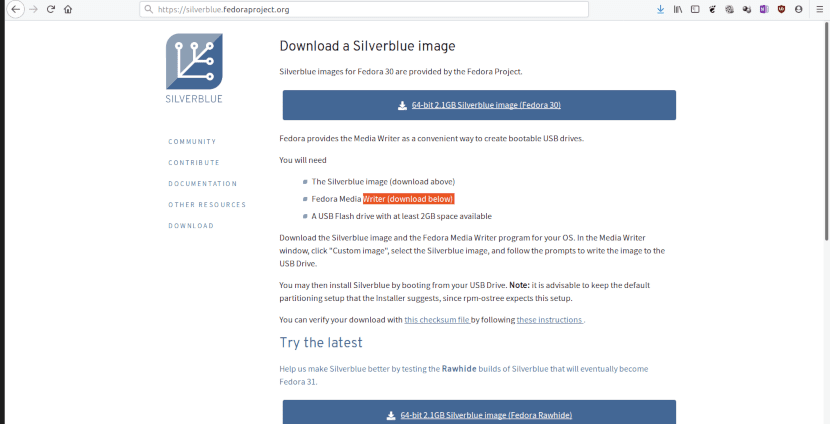
This is the Silverblue project page
Explain what it is Fedora Silverblue it requires knowing its differences with traditional distributions. This distribution is the answer to my complaint about the lack of originality on Linux.
So let's start by quoting the definition given by its developers:
Fedora Silverblue it is an immutable operating system for the desktop. Its goal is to be extremely stable and reliable. Also, it aims to be an excellent platform for developers and for those who use container-centric workflows' Was it clear to you?
Me neither.
Explaining what Fedora Silverblue is with an analogy.
Depending on the way to update, we know two types of distributions:
Those that publish new versions periodically. Fedora itself, Ubuntu or Linux Mint
And the Rolling Releases that are constantly updated: Arch Linux or Manjaro, are good examples.
We could compare the first group to moving to a new house every so often. As for the second, it is like doing periodic renovations in the house in which we always live.
Fedora Silverblue would be like a building to which a new floor is added periodically. Each new floor incorporates improvements and innovations with respect to the previous one. Now, suppose you don't like the new floor or it has leaks. You can simply go back to your old floor and hope they build a new one. And in case you hate the new apartment you can always tear it down.
If you want to understand what Fedora Silverblue is with a more technological example, pThink about the Windows restore point system. However, there are two important differences
- In Fedora Silverblue you can go back and forth as many times as you want.
- Restore points are made by image versions and not by dates.
Similarities and differences with Fedora Workstation
It is possible that being an expert installing Fedora you want to jump into the pool. Do not do it. The installation guide itself recognizes that there are problems when configuring dual boot and manual partitioning. The partitions it supports are:
- / Root
- boat
- / var
Inside / var
- / var / home
- var / log
- / var / container
It should be mentioned that the Silverblue installer is not aware of these limitations and will accept the creation of other types of partitions, even if they do not work afterwards.
Installation of programs
In theory, Fedora Silverblue is easy to install and requires no specialist knowledge. Now if you are wondering where the screenshots are, I couldn't install it. Tried 3 times on Virtualbox 6 and there was no way. Not that the installation process is complicated. Even though Fedora has the least intuitive of the graphical installers, it only takes a matter of seconds to understand.
In case you are lucky and you manage to install it, you have three options to add new programs:
Flatpak: It is the main way to install programs with a graphical interface. It is done exactly the same as in the desktop version of Fedora. You can use both the Software Center and the terminal.
Toolbox: Mainly used for tools used on the command line.
Package layering: It is mainly used for updating the immutable part of the operating system (the host system). Also, it can be used to have multiple versions of programs as drivers at the same time.
Flatpak
It is together with Snap and .Appimage a way to install programs without using operating system dependencies and update them independently of it. Fedora Silverblue can use the same Flatpak repositories as normal Linux distributions
Toolbox
The Toolbox utility makes it easy to create containers to test different combinations of tools and libraries.
The advantages of using Toolbox are:
Avoid the problems of having many development tools and libraries installed, often incompatible with each other.
If something goes wrong, you just have to delete the container. No need to reinstall.
In other words, each container created is like a linux distribution without a graphical interface.
Package stratification
Using package overlay creates a new "implementation", or root of the boot filesystem without affecting the current one. The system must be restarted after layering.
Package layering is generally done from the command line. Although it can be used from the Software Center for those programs that cannot be installed from the Flatpak repositories.
Upgrade system
Operating system updates in Silverblue are fully integrated into the desktop. The system will automatically notify you when an update is available. Default the update is automatically downloaded. This can be changed from the update preferences in the Software Center.
Once an update is ready, it's just a matter of restarting to start using the new version. There is no waiting for the update to install during this reboot.
Conclusion
Fedora Silverblue It is a distribution created for specific purposes. Programmers who want to test their applications in different environments will undoubtedly find it useful. So do the operators of the so-called digital kiosks.
I'm not sure if it contributes too much to the common user. Although without a doubt, some of its technologies will end up being incorporated into the Workstation version of Fedora.
It seems that I will continue with Fedora Workstation….